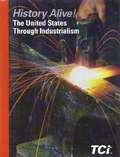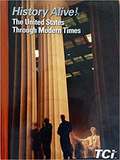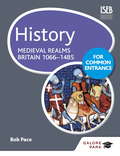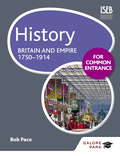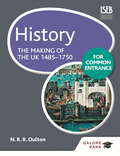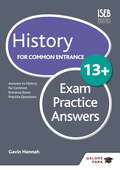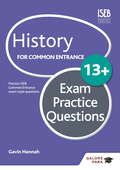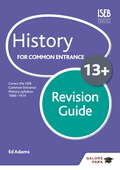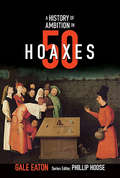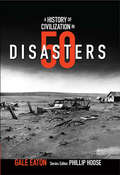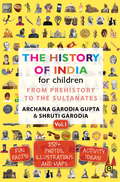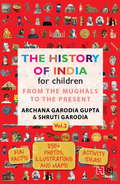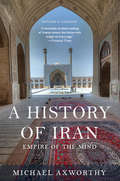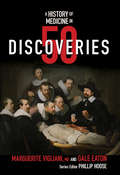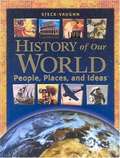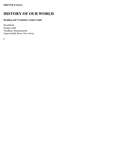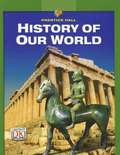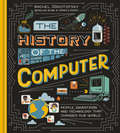- Table View
- List View
History Alive! The United States Through Industrialism, Student Edition
by Teachers' Curriculum InstituteNIMAC-sourced textbook
History for Common Entrance: Medieval Realms Britain 1066-1485
by Bob PaceHistory for Common Entrance: Medieval Realms Britain 1066-1485 ensures a thorough understanding of the 'Medieval Realms' element of the Common Entrance exam syllabus. Clearly presented content, lively illustrations and challenging end-of-chapter questions encourage learning and inspire a love of History. - Endorsed by ISEB - Written by the chief exam setter for ISEB History Common Entrance - Arranged chronologically, to help pupils understand historical context - Includes source-based questions to develop essential exam skills Answer book available separately. See History for Common Entrance: Britain and Empire 1066-1485 Answers Also available from Galore Park www.galorepark.co.uk: History for Common Entrance 13+ Exam Practice Questions History for Common Entrance 13+ Exam Practice Answers History for Common Entrance 13+ Revision Guide History for Common Entrance: Medieval Realms Britain 1066-1485 History for Common Entrance: The Making of the UK 1485-1750 History for Common Entrance: Britain and Empire 1750-1914
History for Common Entrance: Britain and Empire 1750-1914
by Bob PaceHistory for Common Entrance: Britain and Empire 1750-1914 ensures a thorough understanding of the 'Britain and Empire' element of the Common Entrance exam syllabus. Clearly presented content, lively illustrations and challenging end-of-chapter questions encourage learning and inspire a love of History. - Endorsed by ISEB - Written by the chief exam setter for ISEB History Common Entrance - Arranged chronologically, to help pupils understand historical context - Includes source-based questions to develop essential exam skills Answer book available separately. See History for Common Entrance: Britain and Empire 1750-1914 Answers Also available from Galore Park www.galorepark.co.uk: History for Common Entrance 13+ Exam Practice Questions History for Common Entrance 13+ Exam Practice Answers History for Common Entrance 13+ Revision Guide History for Common Entrance: Medieval Realms Britain 1066-1485 History for Common Entrance: The Making of the UK 1485-1750 History for Common Entrance: Britain and Empire 1750-1914
History for Common Entrance: The Making of the UK 1485-1750
by Bob PaceHistory for Common Entrance: The Making of the UK 1485-1750 ensures a thorough understanding of the 'Making of the UK' element of the Common Entrance exam syllabus. Clearly presented content, lively illustrations and challenging end-of-chapter questions encourage learning and inspire a love of History. - Endorsed by ISEB - Written by the chief exam setter for ISEB History Common Entrance - Arranged chronologically, to help pupils understand historical context - Includes source-based questions to develop essential exam skills Answer book available separately. See History for Common Entrance: Britain and Empire 1485-1750 Answers Also available from Galore Park www.galorepark.co.uk: History for Common Entrance 13+ Exam Practice Questions History for Common Entrance 13+ Exam Practice Answers History for Common Entrance 13+ Revision Guide History for Common Entrance: Medieval Realms Britain 1066-1485 History for Common Entrance: Britain and Empire 1750-1914
History for Common Entrance 13+ Exam Practice Answers
by Gavin HannahThis book contains answers to all questions featured in the accompanying title History for Common Entrance 13+ Exam Practice Questions. - Features worked examples of answers to the evidence and essay questions - Provides advice and guidance for achieving top marks - Includes ISEB Common Entrance mark scheme
History for Common Entrance 13+ Exam Practice Questions
by Gavin HannahHistory for Common Entrance 13+ Exam Practice Questions features a wealth of exam-style questions based on the format of the new ISEB Common Entrance exam. Exam Practice Answers is available to accompany this title. - Features questions on all three historical periods tested at 13+ - Contains 30 evidence questions and 30 essay titles for varied practice - Familiarises pupils with the format of the questions to improve exam technique
History for Common Entrance 13+ Revision Guide
by Ed AdamsHistory for Common Entrance 13+ Revision Guide reflects the style and content of the new ISEB Common Entrance syllabus and provides essential support and guidance for thorough exam preparation. - Endorsed by ISEB - Consolidates all the key information required for Common Entrance - Provides tips and advice on how to answer both the evidence and essay questions - Includes 'Test yourself' exercises for focused revision Also available from Galore Park www.galorepark.co.uk: History for Common Entrance 13+ Exam Practice Questions History for Common Entrance 13+ Exam Practice Answers History for Common Entrance 13+ Revision Guide History for Common Entrance: Medieval Realms Britain 1066-1485 History for Common Entrance: The Making of the UK 1485-1750 History for Common Entrance: Britain and Empire 1750-1914
A History of Ambition in 50 Hoaxes (History in #50)
by Phillip Hoose Gale EatonWhat do the Trojan Horse, Piltdown Man, Keely Motor Company, and Ponzi Scheme have in common? They were all famous hoaxes, carefully designed and bolstered with false evidence. The con artists in this book pursued a variety of ambitions--making money, winning wars, mocking authority, finding fame, trading an ordinary life for a glamorous one--but they all chose the lowest, fastest road to get there. Every hoax is a curtain, and behind it is a deceiver operating levers and smoke machines to make us see what is not there and miss what is. As P.T. Barnum knew, you can short-circuit critical thinking in any century by telling people what they want to hear. Most scams operate on a personal scale, but some have shaped the balance of world power, inspired explorers to sail uncharted seas, derailed scientific progress, or caused terrible massacres. A HISTORY OF AMBITION IN 50 HOAXES guides us through a rogue's gallery of hustlers, liars, swindlers, imposters, scammers, pretenders, and cheats. In Gale Eaton's wide-ranging synthesis, the history of deception is a colorful tour, with surprising insights behind every curtain.
A History of Civilization in 50 Disasters
by Gale Eaton Phillip HooseThe History in 50 series explores history by telling thematically linked stories. Each book includes 50 illustrated narrative accounts of people and events some well-known, others often overlooked that, together, build a rich connect-the-dots mosaic and challenge conventional assumptions about how history unfolds. The Fall 2015 list also includes A History of Travel in 50 Vehicles. Future titles include A History of Medicine in 50 Discoveries, A History of American Culture in 50 Innovators, A History of the Universe in 50 Milestones, A History of Sports in 50 Athletes, and A History of Progress in 50 Hoaxes. In A History of Civilization in 50 Disasters, Gale Eaton weaves tales of the disasters that happen when civilization and nature collide. Volcanoes, fires, floods, and pandemics have devastated humanity for thousands of years, and human improvements such as molasses holding tanks, insecticides, and deepwater oil rigs have created new, unforeseen hazards yet civilization has advanced not just in spite of these disasters but in part because of them.
A History of Civilization in 50 Disasters (History in #50)
by Gale Eaton Phillip HooseThe earth shakes and cracks open. Volcanoes erupt. Continents freeze, bake, and flood. Droughts parch the land. Wildfires and hundred-year storms consume anything in their paths. Invisible clouds of disease and pestilence probe for victims. Tidal waves sweep ashore from the vast sea. The natural world is a dangerous place, but one species has evolved a unique defense against the hazards: civilization. Civilization rearranges nature for human convenience. Clothes and houses keep us warm; agriculture feeds us; medicine fights our diseases. It all works--most of the time. But key resources lie in the most hazardous places, so we choose to live on river flood plains, on the slopes of volcanoes, at the edge of the sea, above seismic faults. We pack ourselves into cities, Petri dishes for germs. Civilization thrives on the edge of disaster. And what happens when natural forces meet molasses holding tanks, insecticides, deepwater oil rigs, nuclear power plants? We learn the hard way how to avoid the last disaster--and maybe how to create the next one. What we don't know can, indeed, hurt us. This book's white-knuckled journey from antiquity to the present leads us to wonder at times how humankind has survived. And yet, as Author Gale Eaton makes clear, civilization has advanced not just in spite of disasters but in part because of them. Hats off to human resilience, ingenuity, and perseverance! They've carried us this far; may they continue to do so into our ever-hazardous future. The History in 50 series explores history by telling thematically linked stories. Each book includes 50 illustrated narrative accounts of people and events--some well-known, others often overlooked--that, together, build a rich connect the-dots mosaic and challenge conventional assumptions about how history unfolds. Dedicated to the premise that history is the greatest story ever told. Includes a mix of "greatest hits" with quirky, surprising, provocative accounts. Challenges readers to think and engage. Includes a glossary of technical terms; sources by chapter; teaching resources as jumping-off points for student research; and endnotes.
The History of India for Children: From Prehistory to the Sultanates (Vol #1)
by Archana Garodia Gupta Shruti GarodiaThere were ostriches in India. Gold was dug up in the Himalayas by animals. Coins of Greek rulers in India showed Krishna wearing Greek clothes. Ethiopian military slaves founded kingdoms across India. Jump into an action-packed history of India told like never before. Discover our incredible heritage and uncover delightful nuggets about our grand old country. Travel through time and see how people lived, why things happened and how we came to be what we are. Written by BBC Mastermind `Champion of Champions? Archana Garodia Gupta and history-geek Shruti Garodia, this volume spans the ages from the dawn of humans until the Delhi and Deccan sultanates, and tells the story of India?s rulers and invaders, traders and architects, sculptors and poets, scientists and innovators, farmers and businessmen, and millions and millions of just ordinary, everyday men and women. With a chatty style, simple explanations and well-rounded coverage, this is the definitive Indian history in two volumes for young readers. Filled with photographs, illustrations, activities and quotable facts, this is one retelling of history you don?t want to miss.
The History of India for Children: FROM THE MUGHALS TO THE PRESENT (Vol #2)
by Archana Garodia Gupta Shruti GarodiaRembrandt sketched portraits of Jahangir. Akbar?s pet cheetah had its own personal drum procession. A British official often paraded across Chandni Chowk with his 13 Indian wives on elephants behind him. Mahatma Gandhi took his goat, Nirmala, with him everywhere ? even via ship to London! Discover even more amazing facts about our grand old country in this volume. Travel through time and see how people lived, why things happened and how we came to be what we are. Written by BBC Mastermind `Champion of Champions? Archana Garodia Gupta and history-geek Shruti Garodia, this volume covers the centuries from the Mughals to Modi, and continues the story of India?s movers and shakers, artists and traders, patriots and traitors, and the millions of ordinary folk. With a chatty style, simple explanations and well-rounded coverage, this is the definitive Indian history in two volumes for young readers. Filled with photographs, illustrations, activities and quotable facts, this is one retelling of history you don?t want to miss.
A History of Iran: Empire of the Mind
by Michael AxworthyIran is a land of contradictions. It is an Islamic republic, but one in which only 1.4 percent of the population attend Friday prayers. Iran's religious culture encompasses the most censorious and dogmatic Shi'a Muslim clerics in the world, yet its poetry insistently dwells on the joys of life: wine, beauty, sex. Iranian women are subject to one of the most restrictive dress codes in the Islamic world, but make up nearly 60 percent of the student population of the nation's universities. In A History of Iran, acclaimed historian Michael Axworthy chronicles the rich history of this complex nation from the Achaemenid Empire of sixth century B.C. to the present-day Islamic Republic. In engaging prose, this revised edition explains the military, political, religious, and cultural forces that have shaped one of the oldest continuing civilizations in the world, bringing us up modern times. Concluding with an assessment of the immense changes the nation has undergone since the revolution in 1979, including a close look at Iran's ongoing attempts to become a nuclear power, A History of Iran offers general readers an essential guide to understanding this volatile nation, which is once again at the center of the world's attention.
A History of Medicine in 50 Discoveries (History in 50 #0)
by Marguerite Vigliani Gale Eaton Phillip HooseVigliani and Eaton’s high-interest exploration of medicine begins in prehistory. The 5,000-year-old Iceman discovered frozen in the Alps may have treated his gallstones, Lyme disease, and hardening of the arteries with the 61 tattoos that covered his body—most of which matched acupuncture points—and the walnut-sized pieces of fungus he carried on his belt. The herbal medicines chamomile and yarrow have been found on 50,000-year-old teeth, and neatly bored holes in prehistoric skulls show that Neolithic surgeons relieved pressure on the brain (or attempted to release evil spirits) at least 10,000 years ago. From Mesopotamian pharmaceuticals and Ancient Greek sleep therapy through midwifery, amputation, bloodletting, Renaissance anatomy, bubonic plague, and cholera to the discovery of germs, X-rays, DNA-based treatments and modern prosthetics, the history of medicine is a wild ride through the history of humankind.
History of Our World: People, Places, and Ideas
by Henry BillingsThe book provides lessons designed for remedial readers and special needs children. This book offers three proven approaches to the study of World History: standards-driven global approach, a practical and instructional skills development approach and a reading approach. The History of Our World focuses on building fundamental social studies knowledge and skills in the context of an effective reading approach to social studies content.
History of Our World: Reading and Vocabulary Study Guide
by Dorling Kindersley Publishing Staff Heidi Hayes Jacobs Michal L. LeVasseur Kate Kinsella Kevin Feldman Prentice Hall Direct Education StaffThe Reading and Vocabulary Study Guide was designed to help you understand World History content. It will also help you build your read¬ing and vocabulary skills. Please take the time to look at the next few pages to see how it works!
History of Our World: Early Ages
by Heidi Hayes Jacobs Michal L. Levasseur Kate Kinsella Kevin Feldman Dorling Kindersley Publishing StaffTextbook of early and classical history
History of Our World: The Early Ages, Tennessee
by Heidi Hayes Jacobs Michal L. Levasseur Kate Kinsella Kevin Feldman Andrew HeritageNIMAC-sourced textbook
The History of the Computer: People, Inventions, and Technology that Changed Our World
by Rachel IgnotofskyA strikingly illustrated overview of the computing machines that have changed our world—from the abacus to the smartphone—and the people who made them, by the New York Times bestselling author and illustrator of Women in Science.Computers are everywhere and have impacted our lives in so many ways. But who created them, and why? How have they transformed the way that we interact with our surroundings and each other?Packed with accessible information, fun facts, and discussion starters, this charming and art-filled book takes you from the ancient world to the modern day, focusing on important inventions, from the earliest known counting systems to the sophisticated algorithms behind AI. The History of the Computer also profiles a diverse range of key players and creators—from An Wang and Margaret Hamilton to Steve Jobs and Sir Tim Berners-Lee—and illuminates their goals, their intentions, and the impact of their inventions on our everyday lives. This entertaining and educational journey will help you understand our most important machines and how we can use them to enhance the way we live. You&’ll never look at your phone the same way again!
